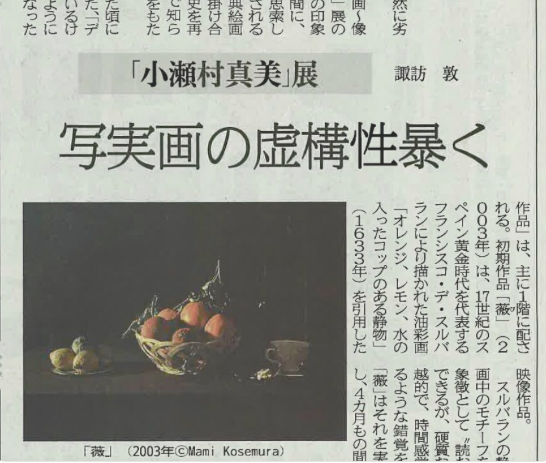
the Kyodo News Service
Newspaper
KYODO NEWS
The Chugoku Shimbun, The Shikoku Shimbun etc.
August, 2020
Mami Kosemura: Phantasies Over Time, Hara Museum of Contemporary Art, 2018
Exposing the Fictional Nature of Realistic Painting
Text: Suwa Atsushi
Publisher: KYODO NEWS and related newspaper companies / Writer: Suwa Atsushi (Painter)
A stroll from Shinagawa Station in Tokyo towards the high plateau known as "Gotenyama" will lead you to the Hara Museum of Contemporary Art, which continues to convey the trends of contemporary art. The Hara Museum is a compact residential art museum that utilizes the modernism architecture by Hitoshi Watanabe, the designer of the former Hattori Clock Shop (now the Wako Building) in Ginza. The structure was first built in 1938 as the residence of industrialist Kunizo Hara, and after the war it was confiscated by the Allied General Headquarters. However, it still retains its original appearance. The Art Deco style interior is unlike the sterile rooms commonly found in modern architecture. The wooden fixtures and staircases, whose aging appearance is gentle on our eyes, continue to deteriorate naturally without being noticed.
The content of the exhibition “Mami Kosemura: Phantasies Over Time ~The Epidermal of Images” matches my impression of the building. Without realizing it, I found myself contemplating the passage of time. Kosemura is an artist known for her video works that reexamine the history of images by merging classical paintings with modern video technology, creating a cerebral viewing experience.
Her works, mainly displayed on the first floor, use digital technology but have the raw vibrance of an oil painting which embodies the desires she had as an art student in the oil painting department. Her early work, “Sweet Scent” (2003), is a video work based on the oil painting "Still Life with Oranges, Lemons and a Glass of Water" (1633) by Francisco de Zurbaran, one of the most representative painters of the Spanish Golden Age in the 17th century. The motifs in Zurbaran's still life paintings can be "interpreted” as religious symbols, but even without that, the rigid depiction itself is transcendental and gives the viewer the illusion of losing all sense of time.
For the work "Sweet Scent," She replicated the painting using actual objects, and followed a photographic process that involved fixed-point observation for four months. She then corrected and connected the huge number of photographs taken of the decomposition process of the "unpreserved”objects on the table, and turned them into a nine-minute animation or 'moving painting'. Painting is still a powerful medium in that it can portray time, encompassing the artist's own visual experience and the time of creation. In her video work “Sweet Scent”, she exposes the fact that the motifs in a Zurbaran's painting cannot actually be arranged as they are depicted in the painting, in the process of replicating the scene reproduced in the painting in reality. By revealing this process of creation at the same time as showing her works, she critiques the fictional nature of realistic paintings, which are supposed to capture reality. As if creating a chimera combining video and painting, Kosemura has incorporated a double timeline into a single virtual space in this work. When the viewer notices a shadow emerging around a table in the work, her intentions become apparent. The shadows in the work were recorded by the artist herself, who photographed the set. The artist's own shadow was only recorded for a few hours, though four months of time spent photographing the still life on the table are also included in this same timeline. In short, the time of a human shadow wandering around unrelated to the still life is infused in the same work. By inserting the photographer's own figure in this way, she emphasizes that this work is different from a painted picture. At the same time, however, the image is projected on an LCD monitor, which is installed in the exhibition space mimicking a classic picture frame.
This strange group of works is both fascinating and thought-provoking, as the videos have a characteristic of appearing and disappearing, yet they also have the strength of paintings. In this exhibition, the actual motifs used in her works are also on display. As for the overall exhibition structure, visitors can also experience the history of Kosemura's works by going back to the first room. Her recent video work, "Pendulum" (2016), shows regular and perpetual motion and the visual transformations that occur within it. The composition of this exhibition seems to imply that the entire exhibition has a nested relationship with this work. The large time axis of this building, the Hara Museum of Contemporary Art, further contributed to this nested structure, and my consciousness was completely captivated in this labyrinth.
(A Painter)
_________________________________________________________________
KYODO NEWS, founded in November 1945 as a nonprofit cooperative organization, is the leading news agency in Japan.
https://www.kyodonews.jp/english/about/whatskyodo.html